As the name suggests, international SEO is just regular SEO (plus a few varying techniques) that allows you to boost your site’s visibility in SERPs for various countries and regions. By following international SEO best practices and implementing these in your content strategy, you’ll effectively be able to drive organic traffic (and conversions) from various geographic locations.
Before diving into the only local SEO checklist you’ll ever need (+ actionable steps), you have to answer the following question: Is an international SEO strategy right – for you?
Here are a few questions to answer before continuing – if you answer yes to all of these questions, you’re in a great spot to implement an international SEO strategy. If you answer no to some of the following, please check out the finer print below the question.
- Is there a demand for your product/ service in international markets?
- Tools like Google Trends, market research reports, and competitor analysis will help identify potential demand.
- Has an international interest in your business been shown?
- Take a look at your website analytics (GA4, for example). A significant number of visitors from alternative countries could indicate interest and potential.
- Do you have the resources to build an international SEO strategy? (Budget, team, or other resources)
- This includes content localization, handling a variety of target languages, and managing internal SEO efforts.
- Don’t worry if you don’t have the necessary skills.
5 Steps (& Best Practices) to Create an International SEO Strategy
As mentioned, you need to develop a strategic approach to reach (and convert) global audiences effectively. Along with our handy checklist, here are the steps you need to develop a thorough strategy.
Define Your International Market & Conduct Market Research
At this point, you probably already know which specific foreign markets you want to target based on SEO and non-SEO factors. It’s important to look at both of these factors to ensure you’re not missing out on potential opportunities where there is huge demand and low competition.
Side Note: Of course, you need to dig deeper than this initial potential research to target specific countries. We’ll get to validate your specific regions in the following sections.
SEO Metrics to Consider
When looking at SEO metrics to consider while looking at more potential countries to target, it is best if you can either use Google Analytics 4 or Ahrefs.
Using Ahrefs to look at SEO metrics:
- Head on over to the site explorer section and insert your domain.
- Scroll down until you find the traffic by location section.
- Follow the same process when looking at your competitors to ensure you’re not missing out on any missed opportunities.
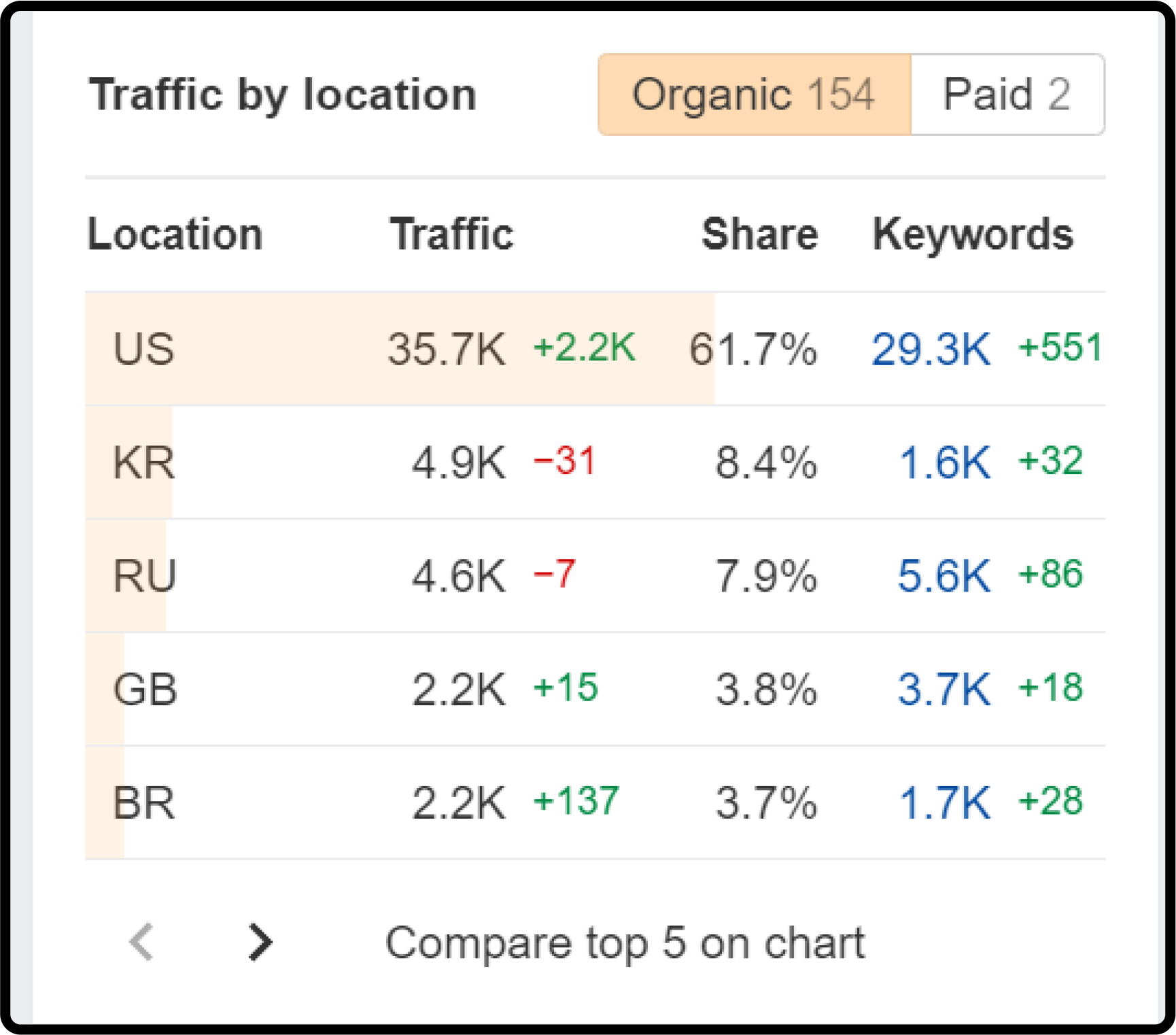
Now that you’ve developed your list of potential regions to target, it’s time to conduct thorough market research.
Conduct Market Research
In order to understand your potential new audience’s behavior and build your newly-found international SEO strategy, you need to conduct thorough market research. The best way to do this is to use SEMrush’s market explorer tool to learn more about specific audiences, discover a handful of keywords, and more.
Using SEMrush to conduct market research:
- Open the SEMrush market explorer and click on find competitors.
- Next, add your domain and one of your potential locations.
- Click on research a market.
- From here, you can get all the relevant information in the audience and overview tab. Using the overview tab, you can look at relevant keywords for the specific location, competitors, and potential traffic.
- Once you head over to the audience tab, you can find all sorts of information regarding your target audience (age, social media usage, domains they regularly visit, and interests).
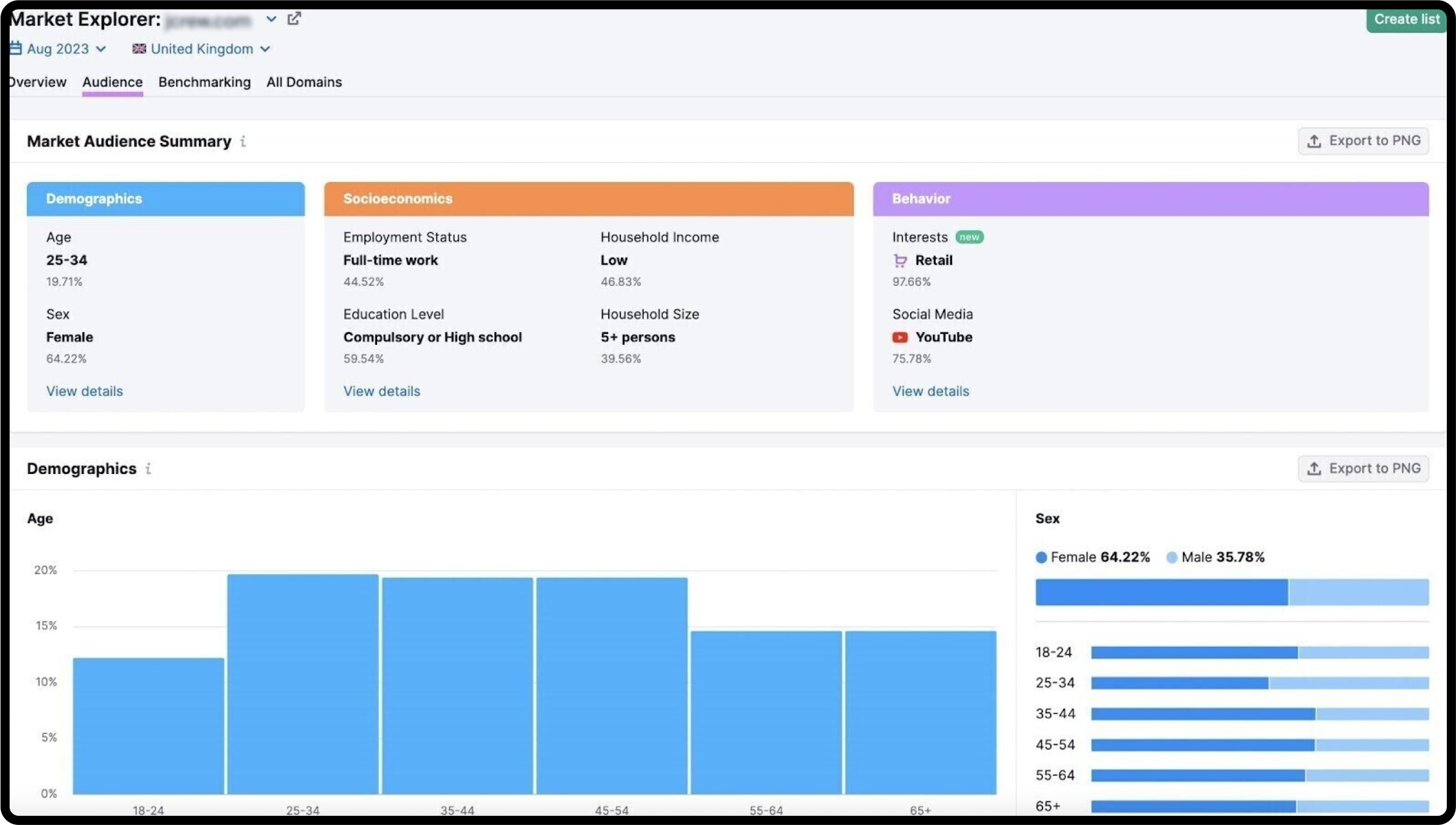
After conducting the above-mentioned research, you’ve now established which countries you’d like to target based on competitor and internal potential, as well as thorough market research.
Strategic Keywords: Identifying Opportunities for International Targeting
Research Before Keyword Research
Firstly, before diving head-first into your strategic keyword research, you need to do further research to establish whether the users of your selected countries have a variety of official languages.
For example, let’s say you want to target Canada. Both French and English are the official languages of the country, which is why you’ll effectively need to roll out an English-Canadian and a French-Canadian version of the pages you want to use to target this audience.
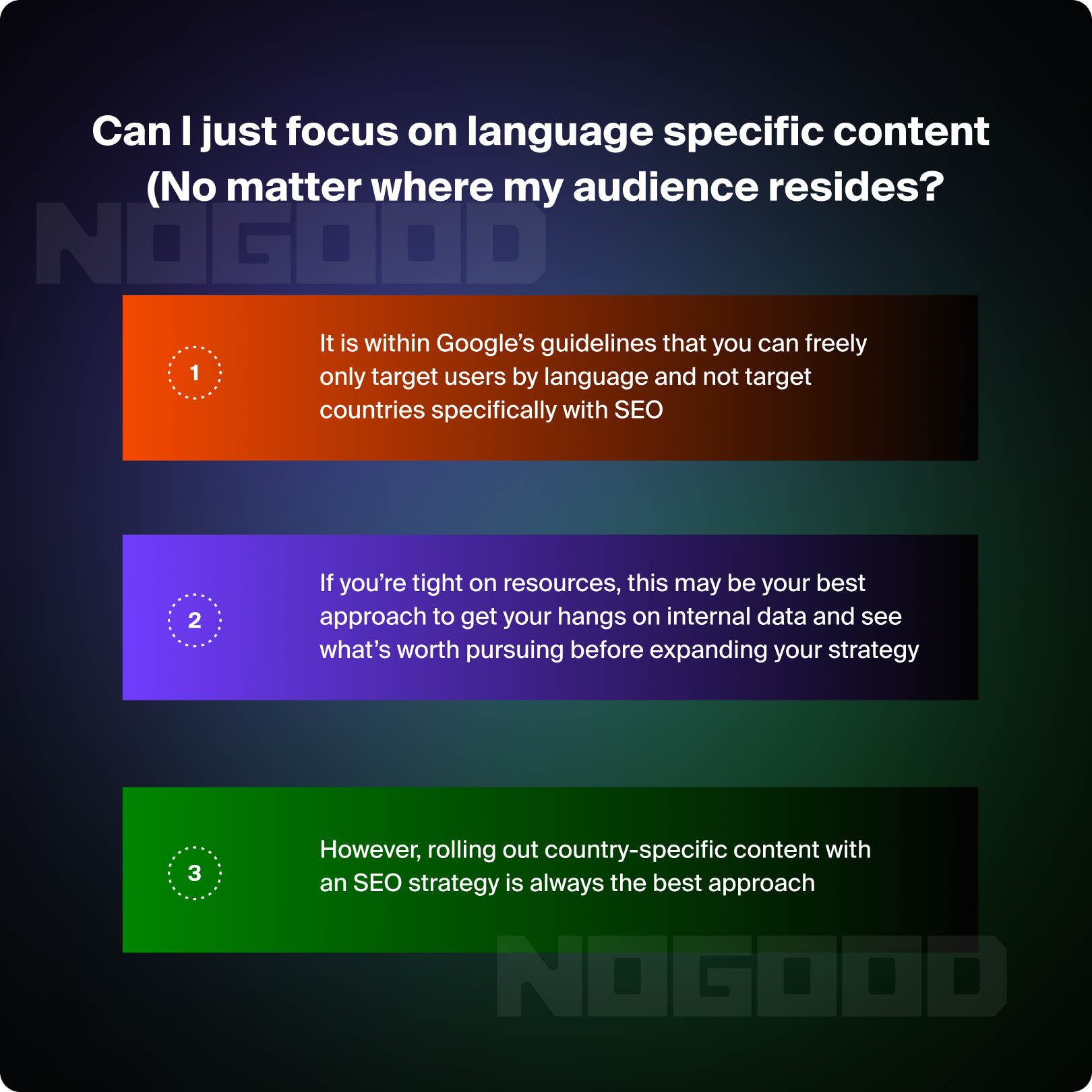
With this in mind, it’s time to start the keyword research process.
Identifying Keyword Opportunities
While conducting international keyword research, you should always consider the following:
- Language variations
- For example, Canadian English isn’t the same as American English.
- Cultural nuances
- For example, let’s say you’re building out your French pages for Black Friday. You can’t simply translate the keyword “Black Friday” to “Vendredi Noir,” as this would be culturally inappropriate. Even though this is a correct literal translation, you’d effectively be referring to the November 2015 Paris attacks.
- Specific search behaviors in global markets
- Let’s take the example of you optimizing the first version of your website for America. You may have used the strategy of optimizing for voice search, as this is a popular search method for this location. However, let’s say you want to target China, you won’t be able to follow the same strategy as voice search isn’t as big there. You’d have to start thinking about optimizing your content for Baidu, which is the leading search engine in China.
Next, it’s best to do competitor research once again to uncover valuable business opportunities. Head over to any keyword research tool, like Ahrefs or SEMrush, insert your domain, and add your competitors. You’ll have a list of keywords for which you outrank your competition and keyword opportunities.
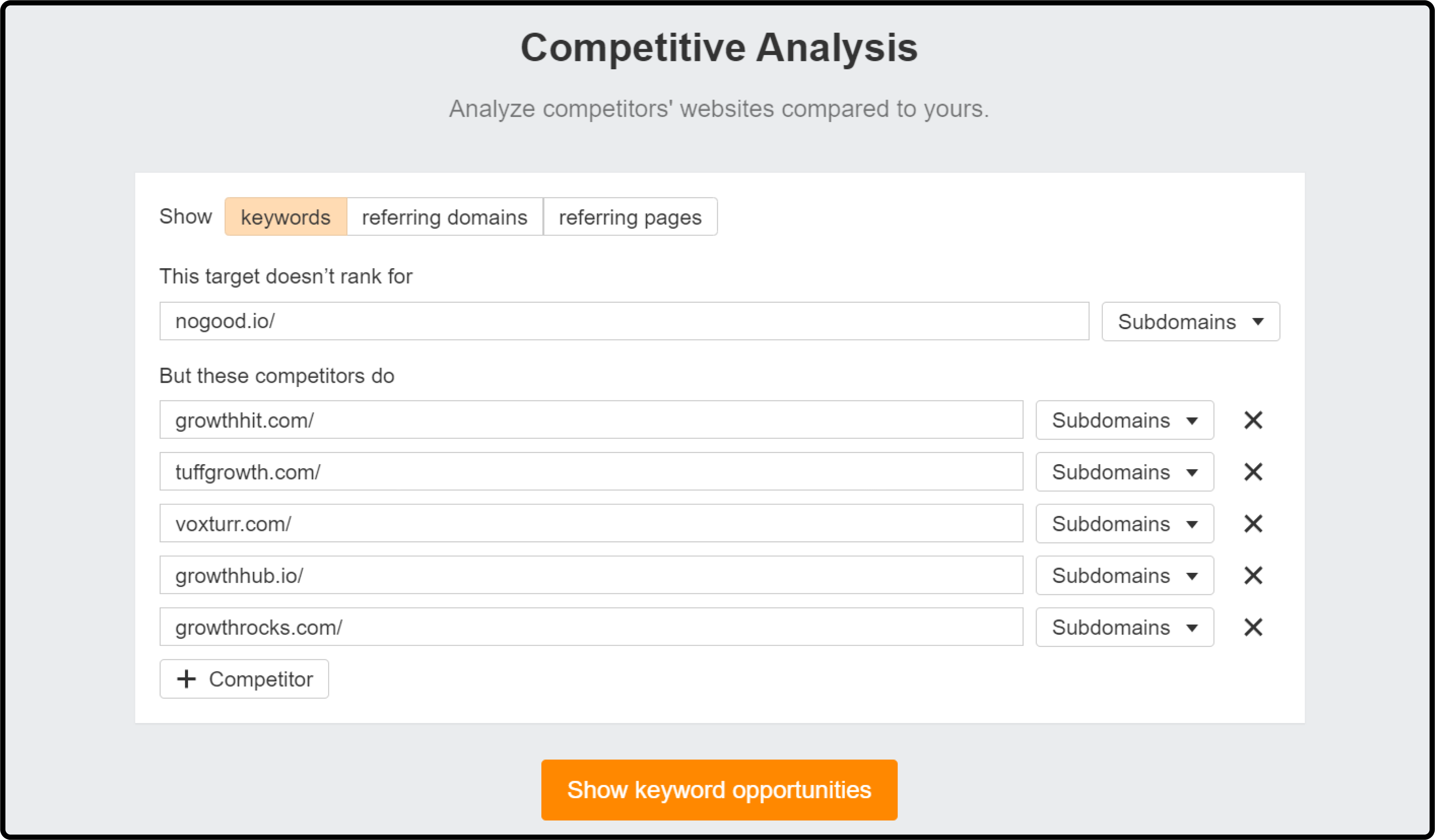
Next, take the keywords you’ve gathered from analyzing your competitors and look at the keyword metrics for each one to ensure there is enough opportunity to make it worthwhile. Be sure to add the target country to find the correct information.
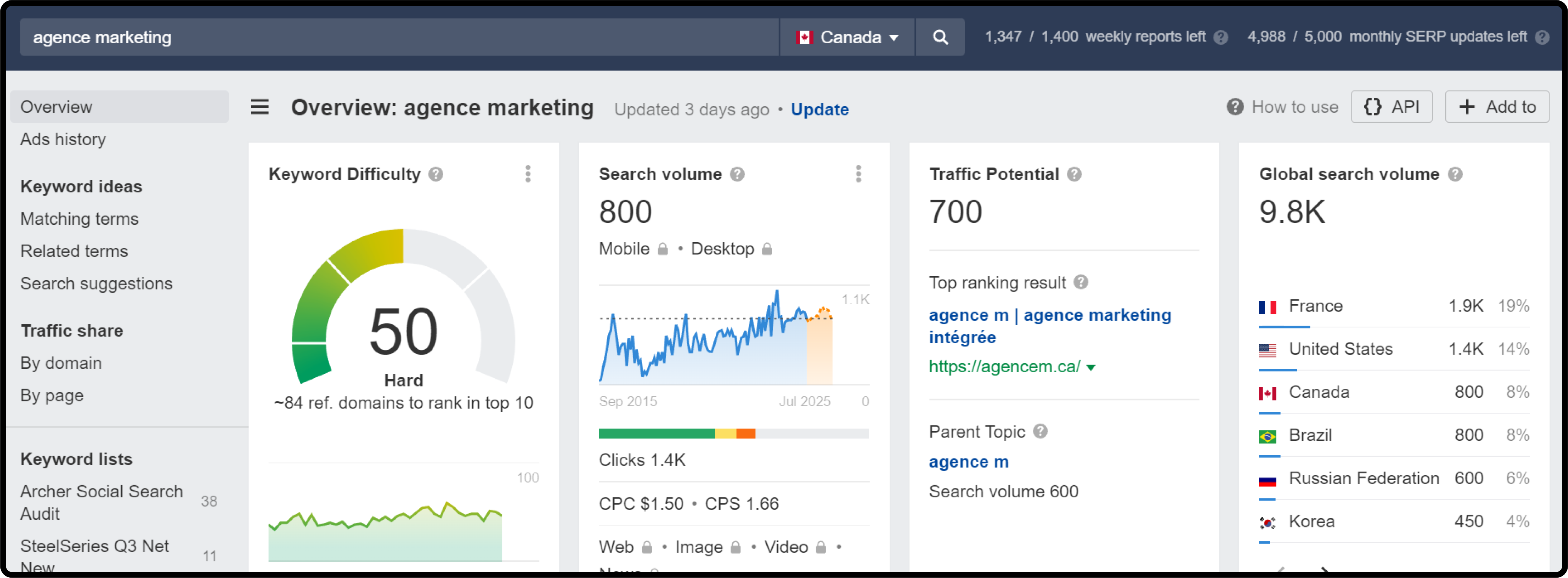
After finding initial keywords with good volume, be sure to check out their matching and related terms. By doing this, you’ll be able to hunt down much more niche keywords (and potentially keywords with more search volume).

Adapt Your Content Strategy for Cultural Preferences
Your content strategy must go beyond simple translation to succeed in global markets. Considering the audience’s unique values, communication styles, and cultural norms is essential. This means localizing your content rather than just translating it.
Translation vs. Localization
- Translation involves converting content from one language to another while keeping its original meaning. It focuses on accuracy and ensuring the message remains consistent across languages. Often, SEOs just use translation tools (like DeepL) and automatically translate various pages without having a content quality evaluation process in place.
- Content localization, on the other hand, considers regional, cultural, and contextual factors. It adapts content to the preferences and expectations of a specific audience, ensuring it resonates more deeply. This approach contributes to higher user engagement and helps build a positive brand reputation in new markets.
Key Considerations for Localizing Content
Understand Regional Values and Communication Styles
Your region-specific content should align with the audience’s unique values and communication styles. This involves understanding cultural norms and traditions. For example, humor that works well in one culture might not be understood or appreciated in another.
Use Local Examples and Authoritative Links
Incorporate links to sites that are recognized as authoritative in your new market. Using local examples and references can make your content more relatable. For instance, mentioning local events, holidays, or well-known personalities can enhance engagement.
Cultural Relevance in Visuals
Visuals play a significant role in content localization. Use images, colors, and symbols that are familiar and appealing to your target market. Ensure your visuals align with local beliefs or customs. For example, the color white symbolizes purity in many Western cultures but is often associated with mourning in some Asian cultures.
Consider Practical Differences
Different regions have varying practical needs and expectations. These include:
- Sizing and Fit: Clothing sizes can vary significantly by country or continent. Ensure your size charts are localized.
- Date Formats: Different regions use different date formats (e.g., MM-DD-YYYY in the U.S. vs. DD-MM-YYYY in Europe). This can affect everything from event planning to product launch dates.
- Seasonal Differences: Seasonal differences can impact how your content is received. For example, summer in the U.S. coincides with winter in Australia. Plan your campaigns and content releases accordingly.
- Currency and Pricing: Display prices in the local currency and consider the local economic context when setting prices.
- Legal and Regulatory Compliance: Ensure your content complies with local laws and regulations, such as the General Data Privacy Regulation (GDPR) in the EU.
Enhance Engagement with Cultural Sensitivity
Localizing your content instead of merely translating it can create a deeper connection with your audience. This approach shows respect for their culture and values, which can enhance trust and loyalty. When done effectively, content localization can drive higher engagement and support your brand’s success in new markets.
Developing A Reputation Management Strategy
A strong reputation management strategy is essential for gaining credibility and driving traffic in new markets. One effective approach is to secure backlinks from reputable websites in your target region. Backlinks not only help your website rank faster but also drive traffic to your regional pages.
Attracting Backlinks from Locally Relevant Sites
To attract backlinks from locally relevant sites, your content needs to resonate with local audiences. As mentioned, simply translating content won’t do the job if the imagery and statistics aren’t relevant to the local context. For example, an infographic on hiring stats in the U.S. translated into French won’t provide value to your audience in France. Instead, including local hiring stats and region-specific visuals ensures the content is relevant and more likely to gain backlinks.
Effective Content Formats for Backlinks
Certain content formats are more likely to attract backlinks. Further, these are also best practices for optimizing your content after Google AI Overviews are rolled out and aligned with Google’s guidelines.
These include:
- In-depth guides: Demonstrating your expertise through comprehensive guides can attract links from authoritative sites.
- Original data and research: Publishing unique research or data relevant to the local market can make your content a valuable resource.
- Guides and tutorials: Practical, how-to content that solves specific problems for your audience is highly linkable.
- Infographics and data visualizations: Visual content that engagingly presents data can be widely shared and linked to.
- Case studies and client success stories: Showcasing real-world applications of your products or services can attract interest and links.
- Interactive content: Tools like quizzes and calculators that engage users can drive traffic and backlinks.
Using SEMrush’s Link Building Tool
To find good backlink prospects and conduct effective outreach, you can use SEMrush’s Link Building Tool. Here’s how:
1. Create a Project
- Open the Link Building Tool and click “+ Create a project.”
- Enter your domain and click “Create project.”
2. Add Local Keywords and Competitors
- Add your local keywords and set the country to your new target market.
- Add the competitors you identified earlier and click “Start Link Building.”
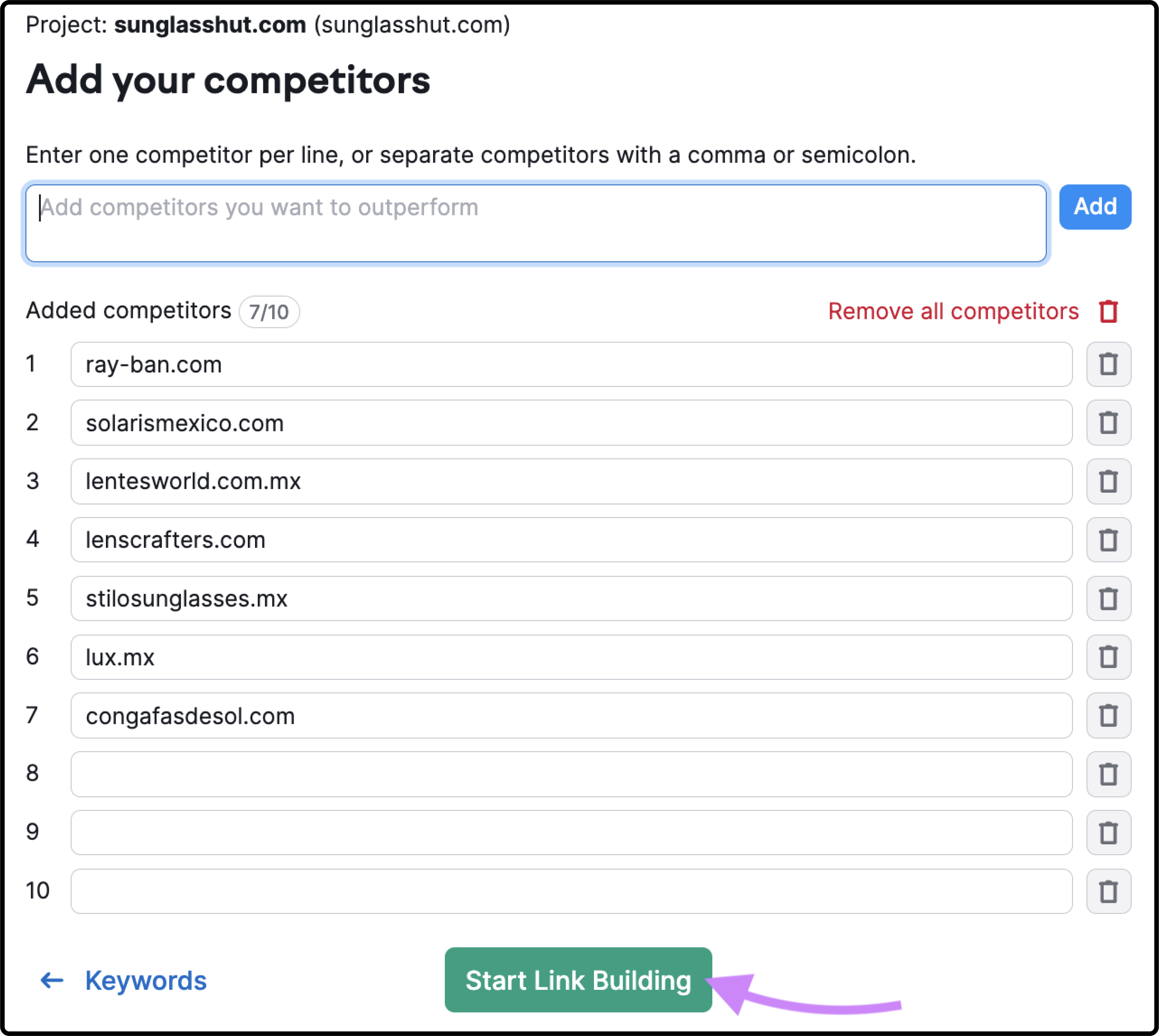
3. Identify Prospects
- When the project is ready, go to the “Prospects” tab to see a list of websites you can reach out to for links to your content.
- Add the most promising prospects to your “In progress” list by clicking the button to the left.
4. Conduct Outreach
- From the “In progress” list, create and send outreach messages. Personalize your emails to explain why your content is valuable and relevant to their audience.
Example of an Outreach Email
Here’s a template for an outreach email:
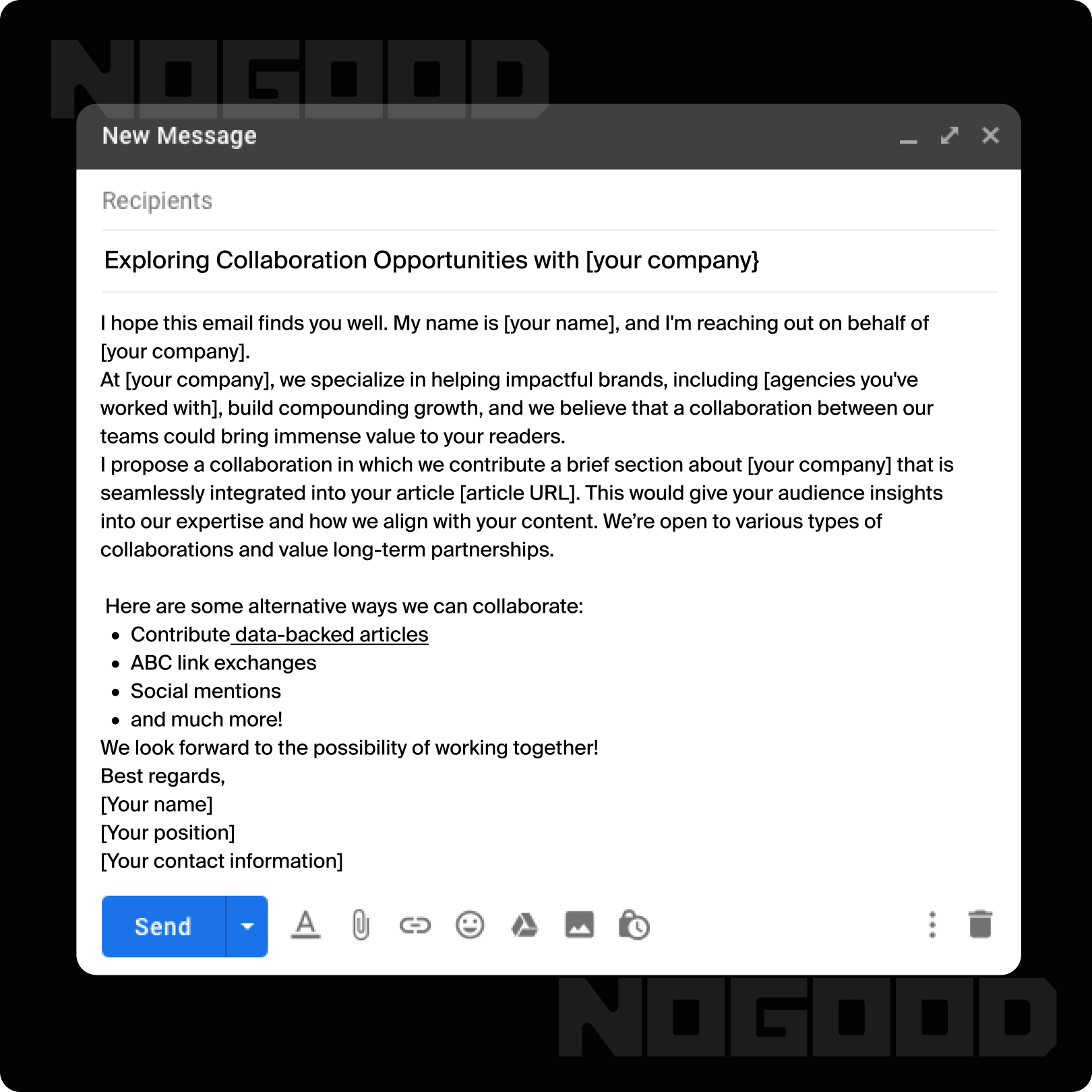
Technical Aspects for International SEO
Addressing technical SEO elements ensures that search engines properly crawl and index your international content, which can improve your website’s rankings and visibility in your target regions.
Implement Region-Specific URLs
A localized URL helps users recognize that your content is relevant to them and assists search engines in understanding the target audience.
Google recommends the following practices:
- Country-Specific Domain (ccTLD): A ccTLD easily separates websites by country. It’s useful when server location doesn’t matter but can be expensive and limits targeting to a single country. Example: www.yourwebsite.au.
- Subdomain with a Generic Top-Level Domain (gTLD): A subdomain with a gTLD is easy to set up and suitable for websites hosted on multiple servers. However, it might not clearly indicate the country or language. Example: www.es.yourwebsite.com.
- Subdirectory with a gTLD: Subdirectories are easy to set up and require little maintenance since you’re using the same host. However, they may not clearly separate sites or indicate the location. Example: www.yourwebsite.com/es/.
Implement Hreflang Tags
Hreflang tags are HTML attributes that inform search engines about the language and regional targeting of webpages on a multi-language or multi-regional website. They signal to search engines which page is the most relevant based on the user’s language and location. This ensures users in a new market are served the correct language version of a page in search results.
Example of hreflang tags for a company in the U.K. serving Spanish content to an audience in Spain:

- link rel=”alternate”: Indicates an alternative version of the webpage.
- href=”https://es.example.com/page”: Includes the alternate page in the target language or region.
- hreflang=”es”: Specifies the language and sometimes a region (e.g., hreflang=”en-us” for English in the U.S.).
Handle Duplicate Content and Canonicalization Issues
Duplicate content can lead to keyword cannibalization, where pages harm each other’s chances of ranking well. Using canonical tags, which indicate the primary version of a webpage, helps prevent content duplication issues.
Example of a canonical tag:

When using both hreflang and canonical tags, specify a canonical page in the same language to avoid conflicting messages to search engines.
Optimize Website Speed and Performance
If your website takes too long to load, bounce rates may increase, and rankings may drop. Use Google’s PageSpeed Insights tool to check page speed and identify issues.
To optimize website speed for global users:
- Use a Content Delivery Network (CDN): Distribute content across multiple servers worldwide.
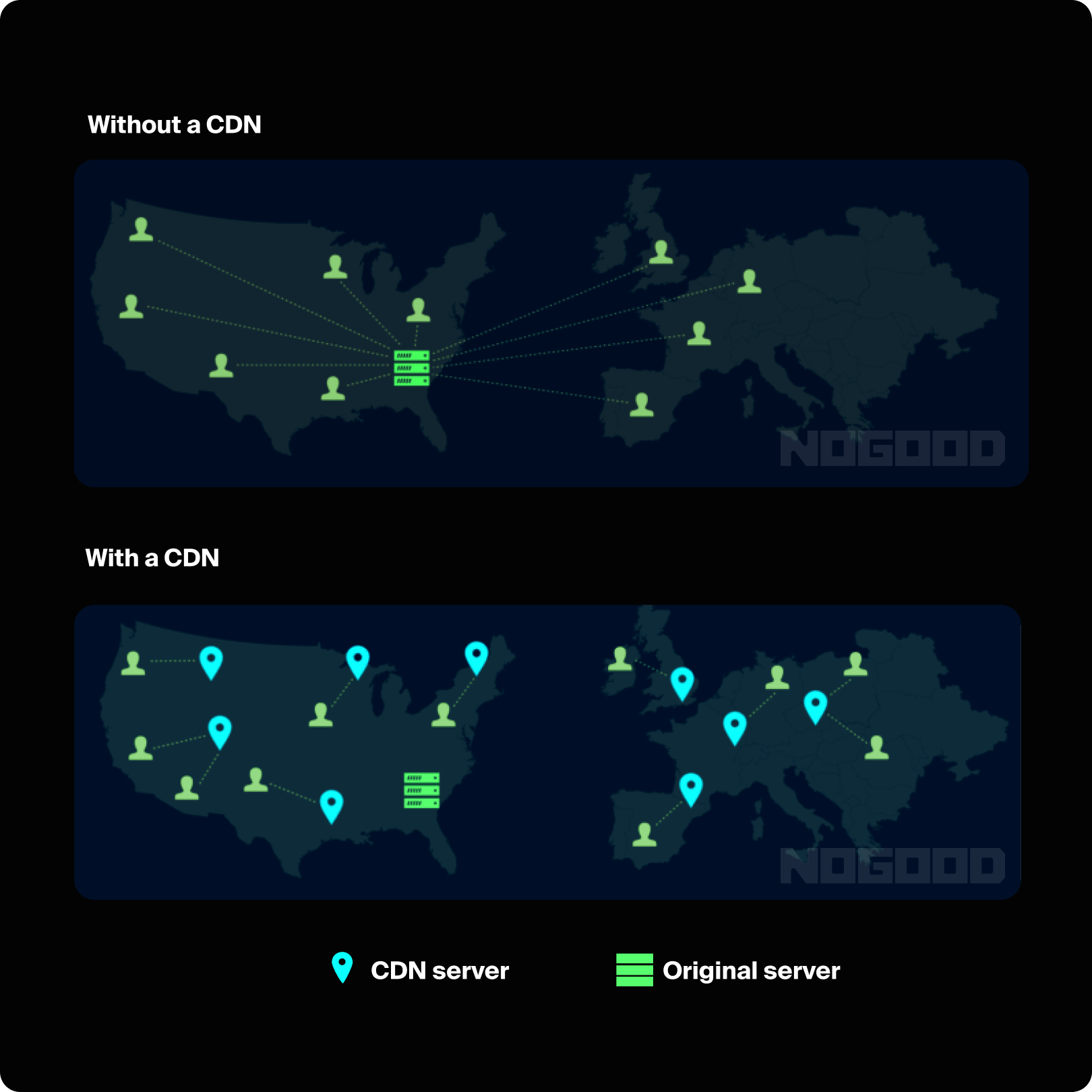
- Compress Images and Files: Reduce page size.
- Ensure Mobile-Friendliness: Optimize your website for mobile devices.
- Implement Caching Policies: Store static HTML versions of pages to serve users quickly.
Planning Your URL Structure
Choosing the right URL structure is vital for international SEO and helps determine where content for each market will live on your website.
Consider the pros and cons of each option:
- ccTLDs
- This is the most popular option on our list, arguably because users are generally more familiar with the top-level domain of their own country. By following this URL structure, users usually get a sense that they’ve landed on the right page.
- Pros: Clear target country, localized hosting.
- Cons: Expensive, challenging technical maintenance, diluted PageRank, no specified language.
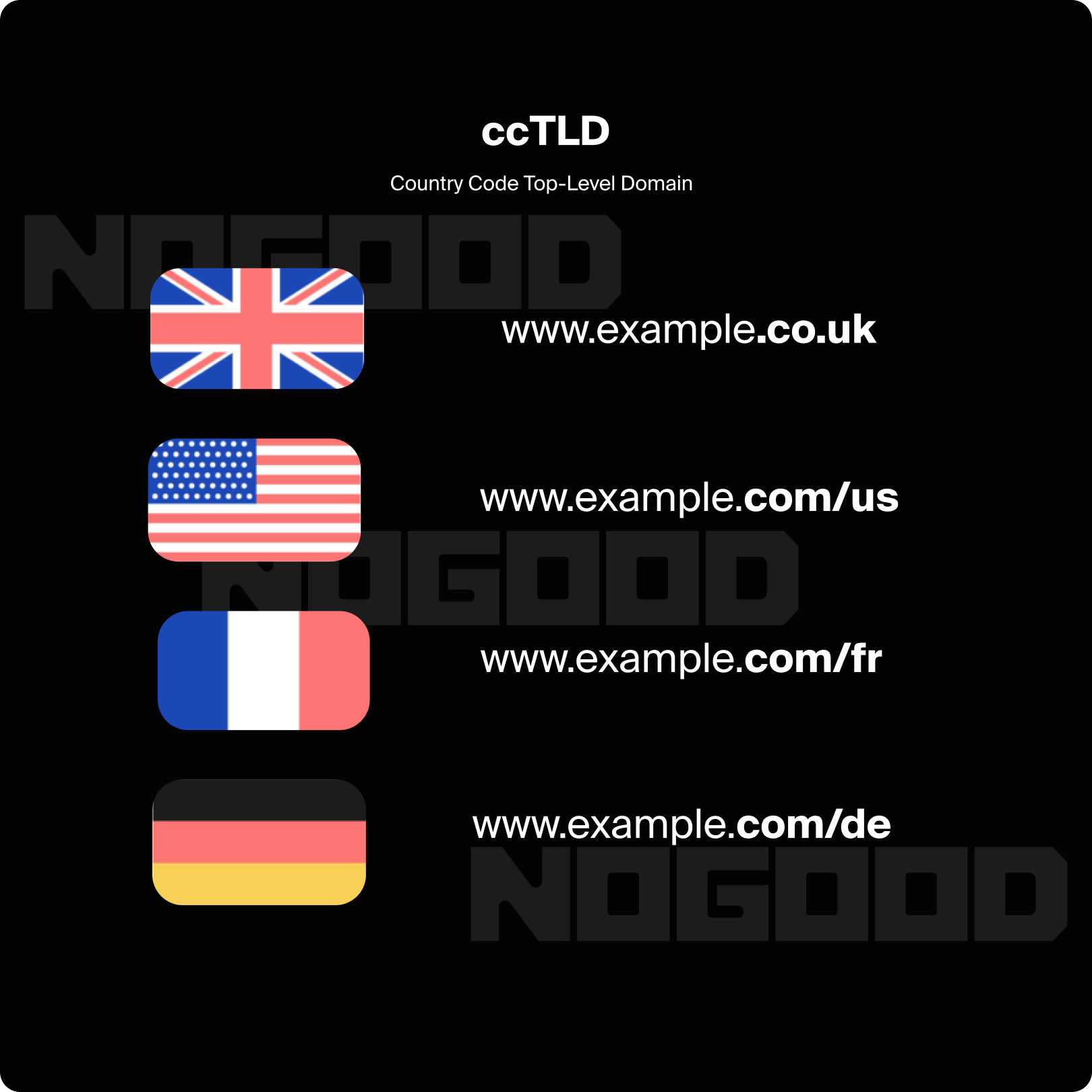
- Subfolders
- By using subfolders, all of your content will be able to sit within one domain. This is great news, as you’ll only need to maintain a single international website. Using subfolders is arguably easier than ccTLDs as it’s easier to create a new single page (as you only have to change the slug) than rolling out a new hosting setup.
- Pros: Single domain maintenance, easy reporting, customizable naming.
- Cons: Less familiar to users.
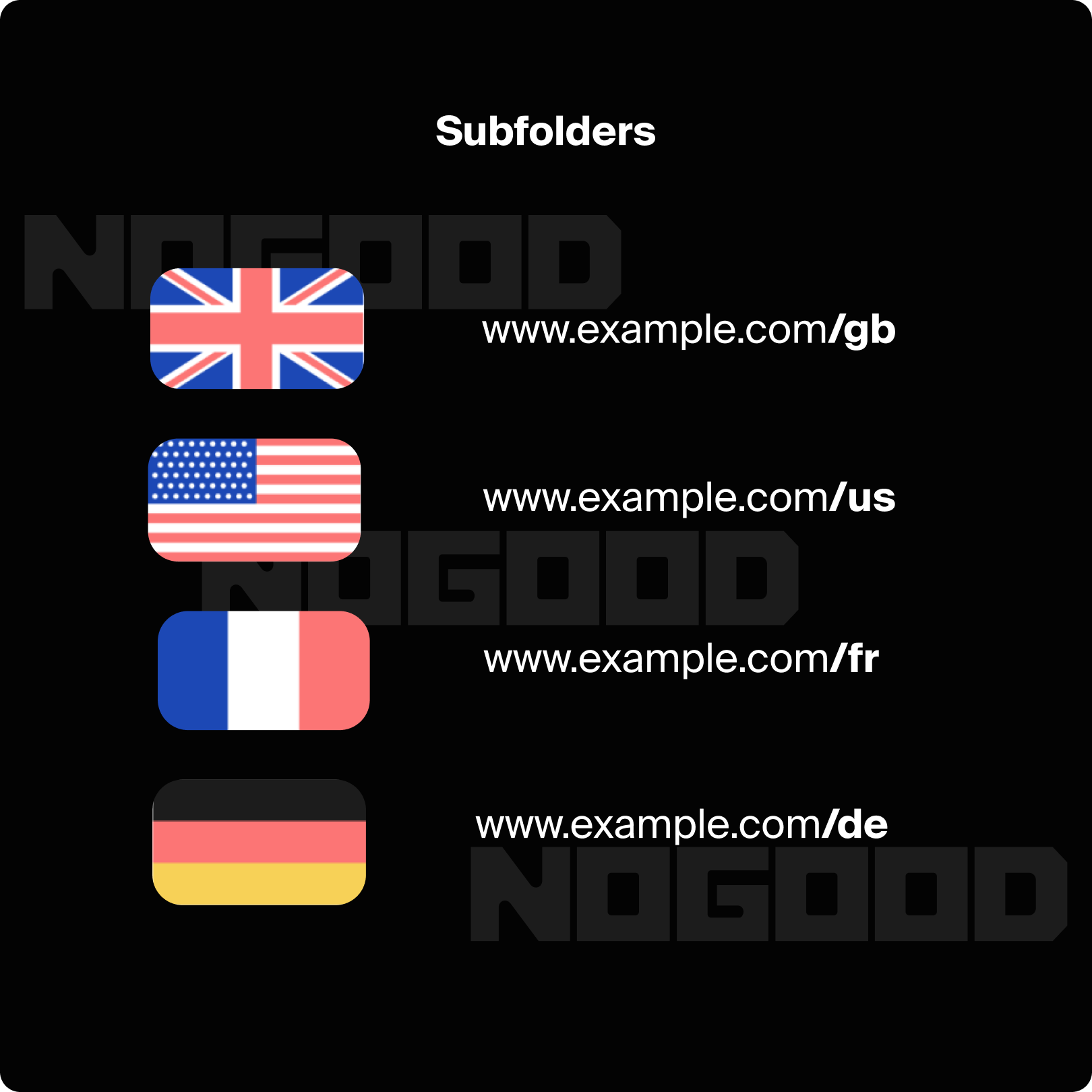
- Subdomains
- If you’re focused on easy reporting, subdomains will be your go-to. By using subdomains, you can customize naming conventions. The cons of using subdomains are closely linked to that of using ccTLD. Even though subdomains are an extension of your domain, Google will have to crawl these separately.
- Pros: Localized hosting, customizable naming conventions.
- Cons: Technically challenging, requires separate SEO efforts, content & design will need to be copied across multiple sites.
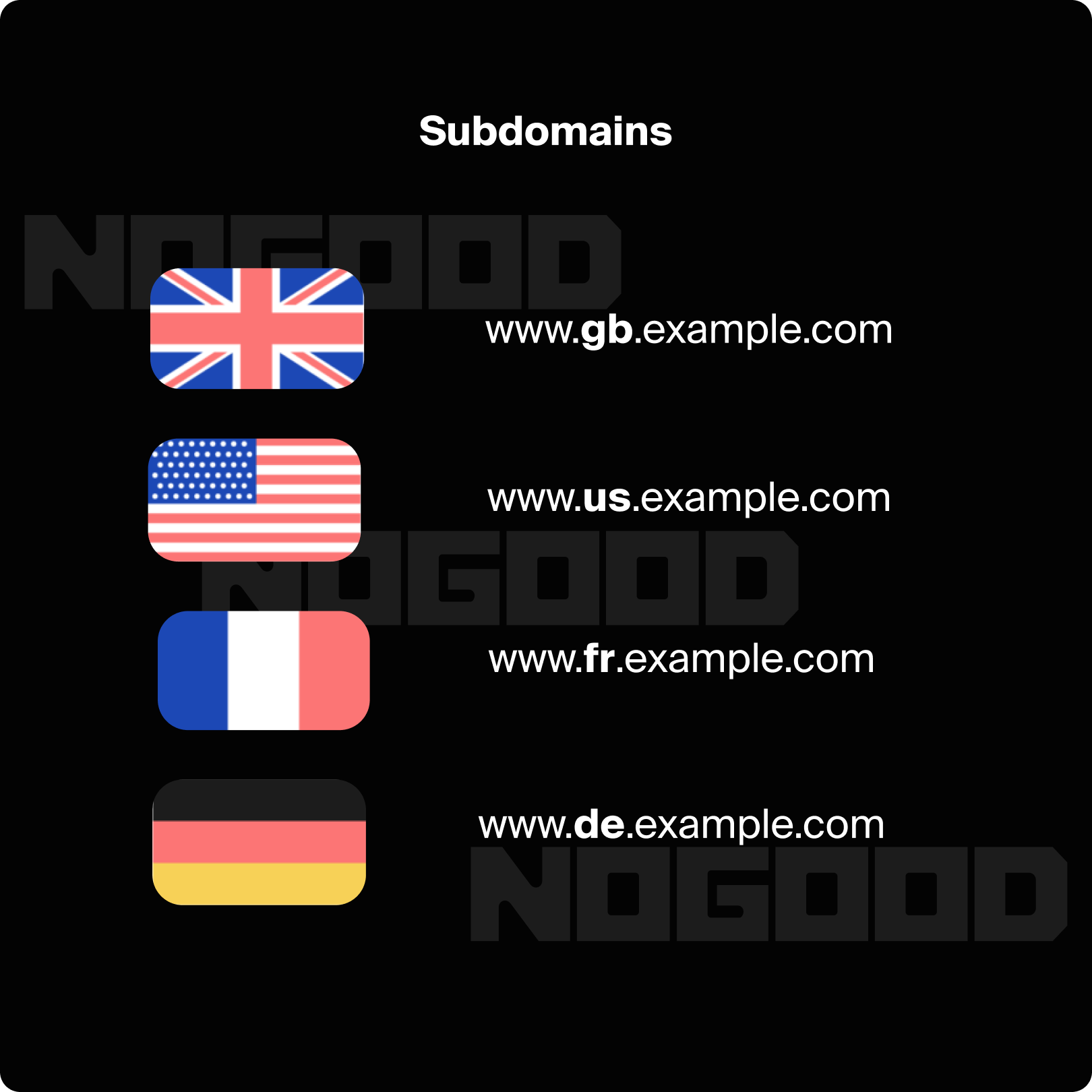
- Parameterized URLs (Avoid This Method)
- Where possible, parameterized URLs should be avoided at all costs. Parameterized URLs are confusing to users and bots. Furthermore, Google does not recommend this option for the purpose of internationalization.
- It is confusing for users and bots, are not recommended by Google.
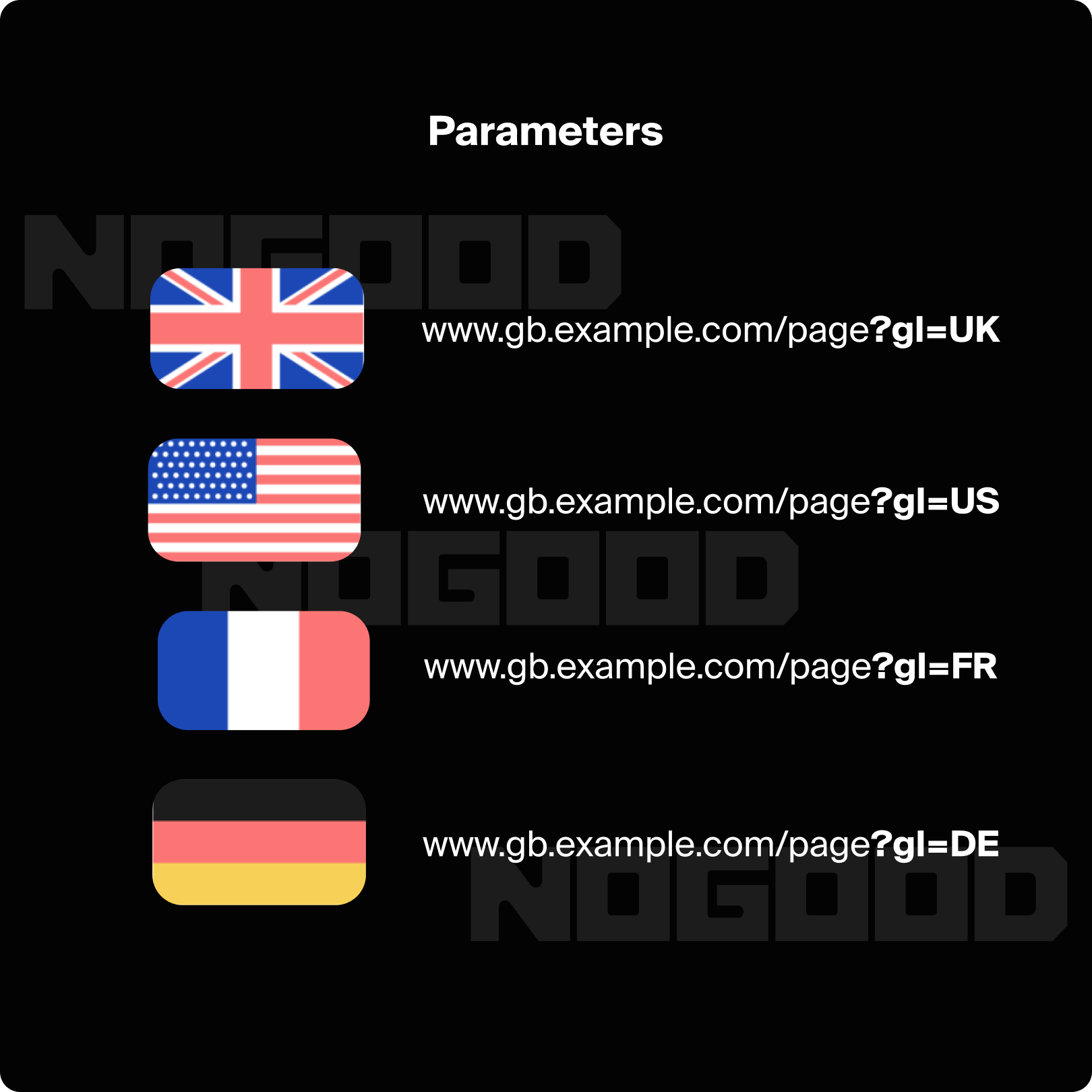
Measuring International SEO Performance
Just like any other SEO strategy, measuring and analyzing your SEO performance is very important to understand which tactics are effective and which ones may need adjustment. Before diving into the data, determine your primary goals for each market you’re targeting. This clarity will guide your analysis and help you focus on metrics that matter.
Setting Up Measurement Tools
Ensure you have the right tools to monitor and analyze user behavior. Google Analytics 4 (GA4) is a platform that can help you identify opportunities for optimization. In GA4, you can find all relevant reports under the “Reports” section in the left sidebar. You can access high-level overviews or more detailed reports depending on your needs.
Key Reports for Tracking International SEO Performance
Here are some essential reports in GA4 for tracking your international SEO efforts:
Traffic Acquisition Report
To access this report:
- Navigate to “Life cycle” in the “Reports” tab.
- Click on “Acquisition.”
- Select “Traffic acquisition.”

This report provides insights into the portion of your overall site traffic that comes organically, how much time these users spend on your website and other engagement metrics. It helps you understand the effectiveness of your SEO strategies in driving organic traffic in different regions.
Landing Page Report
To access this report:
- Go to the “Reports” tab.
- Click on “Engagement.”
- Select “Landing page.”
This report shows which pages typically serve as entry points for visitors to your site. Analyzing landing page performance helps you identify which pages are most successful in attracting and engaging users from different regions.
Using SEMrush’s Position Tracking Tool
For more granular tracking, use a Position Tracking tool (like SEMrush’s) to monitor keyword rankings for each region.
Here’s how to set it up:
- Open the Position Tracking Tool: Enter your domain and click on “Set up tracking.”
- Choose Your Preferences: Select your preferred search engine, device type, and location.
- Add Target Keywords: Enter your target keywords or import them from a file.
- Start Tracking: Click the “Start Tracking” button to begin monitoring your keywords.
The “Overview” dashboard allows you to evaluate your rankings and track changes over time. This helps you assess the impact of your international SEO efforts and adjust your strategies accordingly.
Custom Alerts and Updates
To stay on top of your performance, you can receive ranking updates directly in your inbox. Set custom alerts for specific metrics or changes you want to monitor closely. This proactive approach ensures you are promptly informed about significant shifts in your SEO performance, allowing you to respond quickly.







